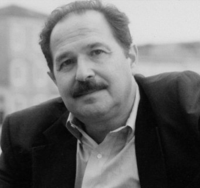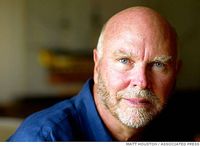As many of you know, my sister Azra has established an annual lecture in memory of her late husband Harvey. While attendance is generally by invitation only, once again I thank Azra for generously providing one hundred seats for 3QD readers. If you (and up to three guests) would like to attend the lecture, RSVP by providing your name in the comments area of this post so that you can be added to the guest list. The first 100 people to respond will be able to come. I am happy to say that my wife and I will also be there this year.
The Ninth
HARVEY PREISLER
Memorial Symposium
Saturday, August 13, 2011
9:00 a.m. to 12:00 p.m.
Dr. J. Craig Venter: From Reading to Writing the Genetic Code
Columbia University Medical Center
Myrna L. Daniels Auditorium
Vivian & Seymour Milstein Family Heart Center
173 Fort Washington Avenue
New York, NY 10032
9:00 am: Reception
9:30 am: Welcome of the honored guests and tribute to Harvey Preisler by
Sheherzad Raza Preisler
9:45 am: Introduction of Dr. J. Craig Venter by Azra Raza
10:00 am: Dr. J. Craig Venter
11:00 am: Questions and Discussion
 Harvey David Preisler, M.D., Director of Rush Cancer Institute and the Samuel G. Taylor III Professor of Medicine at Rush University, Chicago, died on May 19th 2002. The cause of death was lymphoma. Dr. Preisler grew up in Brooklyn, New York, and obtained his medical degree from the University of Rochester, NY in 1965. He trained in Medicine at New York Hospitals, Cornell Medical Center, and in Medical Oncology at the National Cancer Institute and Columbia Presbyterian Hospital in NYC. He then joined Mount Sinai hospital in NY, and subsequently moved to Roswell Park Cancer Institute in Buffalo, NY to direct the Leukemia Service there for the next 14 years. Dr. Preisler was recruited to Rush University as Director of the Cancer Institute in 1992. At the time of his death, he was the Principal Investigator of a ten million dollar grant from the National Cancer Institute in addition to several other large grants which funded his independent research laboratory with approximately 25 scientists. He published extensively including more than 350 full-length papers in peer reviewed journals, 50 books and/or book chapters and approximately 400 abstracts. He was married to Azra Raza, M.D.
Harvey David Preisler, M.D., Director of Rush Cancer Institute and the Samuel G. Taylor III Professor of Medicine at Rush University, Chicago, died on May 19th 2002. The cause of death was lymphoma. Dr. Preisler grew up in Brooklyn, New York, and obtained his medical degree from the University of Rochester, NY in 1965. He trained in Medicine at New York Hospitals, Cornell Medical Center, and in Medical Oncology at the National Cancer Institute and Columbia Presbyterian Hospital in NYC. He then joined Mount Sinai hospital in NY, and subsequently moved to Roswell Park Cancer Institute in Buffalo, NY to direct the Leukemia Service there for the next 14 years. Dr. Preisler was recruited to Rush University as Director of the Cancer Institute in 1992. At the time of his death, he was the Principal Investigator of a ten million dollar grant from the National Cancer Institute in addition to several other large grants which funded his independent research laboratory with approximately 25 scientists. He published extensively including more than 350 full-length papers in peer reviewed journals, 50 books and/or book chapters and approximately 400 abstracts. He was married to Azra Raza, M.D.
A longer tribute to Harvey by Azra: http://3quarksdaily.blogs.com/3quarksdaily/2006/05/rx_harvey_david.html
 J. Craig Venter is a biologist most known for his contributions, in 2001, of sequencing the first draft human genome and in 2007 for the first complete diploid human genome. In 2010 he and his team announced success in constructing the first synthetic bacterial cell. He is a founder and president of the J. Craig Venter Institute (JCVI) and founder and CEO of the company, Synthetic Genomics Inc (JCVI). His present work focuses on creating synthetic biological organisms and applications of this work, and discovering genetic diversity in the world's oceans. Dr. Venter is a 2008 National Medal of Science recipient and is a member of the National Academy of Sciences. He is the author of A Life Decoded: My Genome: My Life (Viking, 2007).
J. Craig Venter is a biologist most known for his contributions, in 2001, of sequencing the first draft human genome and in 2007 for the first complete diploid human genome. In 2010 he and his team announced success in constructing the first synthetic bacterial cell. He is a founder and president of the J. Craig Venter Institute (JCVI) and founder and CEO of the company, Synthetic Genomics Inc (JCVI). His present work focuses on creating synthetic biological organisms and applications of this work, and discovering genetic diversity in the world's oceans. Dr. Venter is a 2008 National Medal of Science recipient and is a member of the National Academy of Sciences. He is the author of A Life Decoded: My Genome: My Life (Viking, 2007).
Roland Pease in the BBC:
